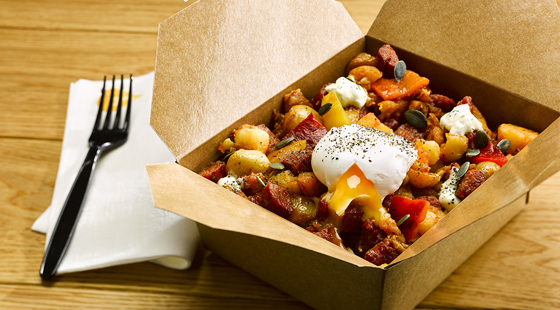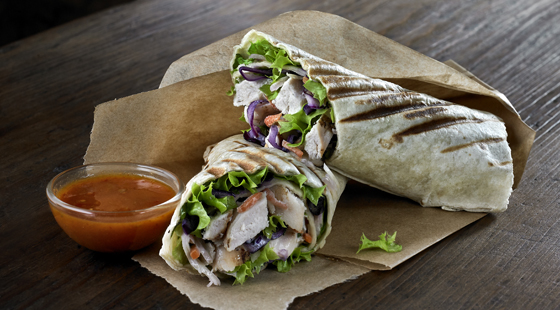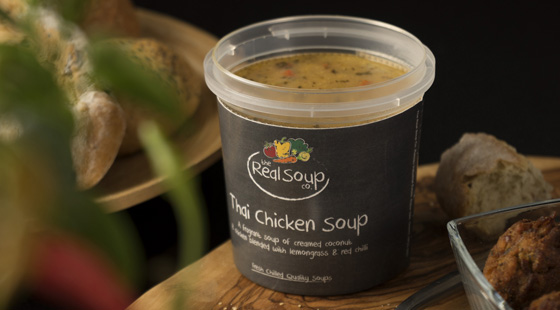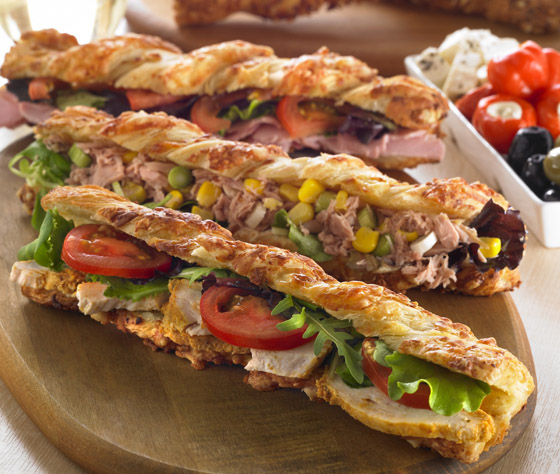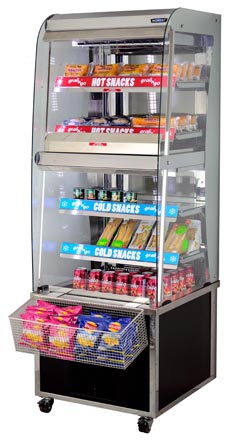Go with a bang – what's hot in grab-and-go food?
and cold - in the grab-and-go food market? Richard McComb reports
Not so long ago, lunch 'on the go' meant grabbing a cheese and pickle sandwich and necking a can of pop. Office workers enjoyed conventional lunch breaks and a pint and a pie was normal, not outlandish.
But the dining landscape has changed beyond recognition and at its heart is a grab-and-go market valued at more than £20b a year. Growth is robust, with MCA's Food to Go Report 2017 indicating a 3.8% increase, compared with less than 2% for the wider eating-out market.
Consumer attitudes are changing too, with food-to-go no longer a strictly working-week option, extending into the weekend and leisure time. However, convenience is still king.
"We have become used to spending less time over our meals, with the minutes we spend, especially during the working day, becoming a finer and finer commodity," says Louise Pilkington, marketing director of Compass Group UK & Ireland. "Convenience is now one of the top pull factors for consumers."
Compass's response has been to launch Chop Chop, a bespoke food-to-go range featuring sandwiches, salads, panini, fruit pots and hot pots. There are classic sandwich options, such as egg and watercress and BLT, as well as more adventurous flavours, such as chicken and artichoke, or goats' cheese and mixed pepper on spianata bread. Chop Chop's 130 items are sold at more than 700 UK sites.
The hot pots satisfy both consumer and operational needs, says Pilkington, as they are assembled off-site and sent to units chilled. Once cooked, dishes such as mac 'n' cheese, vegan chickpea and sweet potato curry, and Asian barbecue pulled pork can be held for two hours - ideal for lunchtime surges in demand.
A convenience revolution
The trend for 'hyper-convenience' - consumers expecting to find their favourite food and drink anywhere, anytime, at the swipe of a screen or touch of a button - has been identified by Nestlé Professional.
"Our recent research confirms that the desire for on-demand food and drink remains strong, with 60% of respondents having eaten breakfast, brunch, lunch or dinner on the go," says Simon Baggaley, Nescafé beverage solutions category manager at Nestlé Professional.
"Meal times are also shrinking, with 70% saying they spend 10 minutes or less on breakfast and a staggering 95% spare less than 30 minutes for lunch. In today's 24/7 culture, fast-paced technologies such as takeaway apps, touchscreen vending, smart ordering and contactless payment are promoting a convenience revolution that is changing the way we eat and drink."
Bidfood expects the market to grow by 4.4% by 2019. Michaela Bateman, the company's non-food category manager, says operators need to provide "robust and practical products" for eating and drinking on the move.
"With 55% of 16- to 24-year-olds welcoming snacks in portable, resealable packaging, it's no surprise that we're seeing a bigger focus on functionality rather than style," she says. "These days, food packaging is often minimal with muted and subtle colours."
'Naked' packaging - where food can be viewed through a clear panel or lid in the container - allows operators to attract consumers and help them make food choices more easily.
Sandwiches and wraps continue to dominate, accounting for 63% of sales, according to research by supplier of eco-packaging, labels and display items, Planglow. Traditional wedge-shaped sandwiches remain the most popular choice followed by 'long breads' such as baguette, ciabatta or panini. A survey by Planglow, based on sales of more than 30.4 million grab-and-go packaging products, points to a growing number of fusion concepts blending Asian and European ingredients and flavours. The firm's own sandwich and wrap packaging comes in four on-trend branded finishes and is fully compostable.
For sandwiches and other grab-and-go products, operators should not underestimate the importance of health messages. "Everyone has become a food analyst," says Nigel Parkes, purchasing and marketing director at Flagship Europe. "Sandwich eaters are more nutritionally aware, particularly since the introduction of FIC, or allergen, labelling as well as the traffic-light systems on packaging. As a consequence, there is a wealth of healthy options, including mayonnaise-free marinades, low-fat and sauce-based fillers."
Daily bread
Timing is everything and it is critical to plan for the daily service schedule to maximise sales and customer satisfaction. That starts with nailing breakfast. A well-stocked breakfast fixture beside a coffee machine, preferably promoting a link deal, is an "absolute must," according to Rebecca Middleton, marketing manager for foodservice at Country Choice: "Within hot beverages, two-thirds is coffee, a quarter tea and the balance hot chocolate, and sales of these products need to be linked to popular food items like breakfast baps, savouries and continental pastries," she says.
"Although breakfast starts very early - 6am for many stores - and continues into mid-morning, the lunchtime trade now starts at about 11am and operators must be sure their offer reflects this.
"It is also worth noting that about 40% of sandwiches are bought outside of the traditional lunch period of 12pm to 2pm, so mid-morning to mid-afternoon availability is key to maximising sales, as is merchandising."
Traditional tastes explain the appeal of soup as an option, and consumers will pay a premium for the personal touch. According to Real Soup Co, which supplies vending and food-to-go outlets, 70% of buyers will pay more for a soup that has been freshly made. Protective sleeves on Real Soup Co's pots of tomato and basil, carrot and coriander and Thai chicken mean they can be eaten straight from the pot.
Go gourmet
There is a dazzling array of breads to tempt customers, from breakfast rolls and lunchtime wraps to pitta pockets. Gordon Lauder, managing director of frozen food distributor Central Foods, points to the continued impact of street food sparking a demand for Asian hirata buns, khoubz (Lebanese flatbread) and chapattis.
"Gourmet fast food is another hot trend this year, with consumers looking for a premium quality in their usual weekday lunchtime and snack staples. The choice or style of bread can make all the difference, and opting for something like a flatbread, instead of the traditional sliced white or brown loaf, is the perfect way to pimp your offering," says Lauder.
Tapping into the street-food explosion adds excitement, too. Jacqui Mee, director of food at Olive Catering Services, says: "By definition, street food relies on a fast, fierce style of cooking that can be served up in just a few minutes, so it is perfectly suited to the way that living and working patterns are changing - anything from burritos to stir-fry boxes can be ideal for those looking to pick up a healthy and delicious meal on the go."
The 'clean eating' movement is becoming increasingly important as consumers look for products that do not negatively impact health. Sue Warren, strategic development director at Wellaby's, says: "There is a huge opportunity for retailers to offer a 'better for you' snack, but it has to taste great. People want to eat more healthily, but healthy snacks are not a compromise on flavour." Wellaby's offers a wholegrain Simple Bakes range that is gluten-free.
The lunch! show in London next month will provide a snapshot of new products, including Virginia Health Food's Squbes, savoury seed cubes, and Big Boss Palm's new Coconut + Vanilla Soda, made from Thai coconut water. Keynote sessions will feature Simon Stenning, executive director at MCA, who flags up growth in the market of 40% in the past decade.
"Consumers are increasingly demanding better quality, more interesting and wider choices, and will not accept cheap and boring," he says. "MCA has elevated 'convenience' to a 'mega trend', recognising this increased demand."
Grab-and-go comes in all forms, of course, including upmarket. Speciality-foods producer and distributor Harvey & Brockless offers a 'cut-to-size' service for cheeses and charcuterie, including sharing platters, dips and dressings. Its development team has created snack, breakfast and lunch solutions ranging from fat-free yogurt pots to snack boxes, all with bespoke packaging.
Other offerings include Sibarita in Covent Garden, which has introduced a range of picnic hampers featuring fine Spanish cheeses, wines and charcuterie, as well as roasted almonds, marinated olives, pickles and a loaf of Hedone sourdough. Pollen + Grace has been launched to fill a perceived gap in the market for healthy and convenient dishes. All products are free from gluten, wheat, dairy and refined sugars, and include a mango and turmeric chia breakfast pot.
And Gordon Ramsay's outlet at Heathrow Terminal 5 has just launched Plane Food Grab & Go for those passengers who are short of time. Options include a sushi tray, lobster and avocado brioche roll, and a grilled chicken Caesar salad. So it seems it's safe to say that grab and go really has taken off.
Equipment dos and dont'sDo…
Maintain food safety Ensure hot and cold displays keep food at the correct temperature. Hot foods, such as meat and sauces, need to be kept at 63°C or above, while salads need to be at or below 5°C.
Ensure food quality Many foods require specific humidity levels to keep fresh and look their best. Fried foods, for example, need a dry heat, while other foods might require a moister environment.
Have decent storage The grab-and-go unit is the front end for fast-moving goods - you need to be able to replenish hot and cold supplies quickly from accessible storage. Your storage unit needs to deliver the same standards of food safety and quality as your grab-and-go unit.
Don't…
Have too big a footprint Most sites will have limited space, so look for units that maximise the display areas. Sliding doors save space on cold units.
Buy inaccessible units There's no point in having the best-looking grab-and-go unit if customers and staff can't access it easily. Units with rear doors for restocking are a bonus if your site layout allows it. Staff should be able to access everything without moving far. Repeatedly walking 5m to a piece of kit is inefficient.
Overlook multi-functional appliances Most grab-and-go sites need cooking equipment such as panini grills. So keep an eye out for multifunctional appliances that offer accelerated cooking. Tips supplied by the Catering Equipment Suppliers' Association chair Glenn Roberts
Contacts
Bidfood
www.bidfood.co.uk
Compass Group
www.compass-group.co.uk
Country Choice
www.countrychoice.co.uk
Flagship Europe
www.flagshipeurope.eu
Harvey & Brockless
www.harveyandbrockless.co.uk
Nestlé Professional
www.nestleprofessional.co.uk
Olive Catering Services
www.olive-catering.com
Planglow
www.planglow.com
Pollen + Grace
www.pollenandgrace.com
Real Soup Co
www.therealsoupcompany.com
Sibarita
www.sibaritalondon.com
Wellaby's
www.wellabys.co.uk
Videos from The Caterer archives
Save


